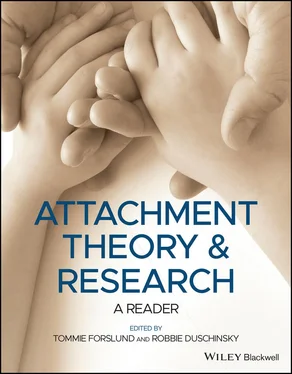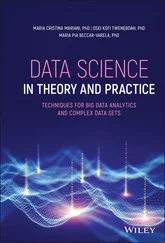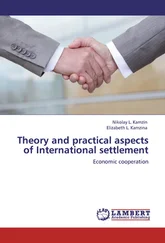Before ending this section a word must be said about the other pathological form of separation anxiety, namely its absence or presence at unusually low levels. It has already been emphasized that some measure of separation anxiety is the inevitable counterpart of a love relationship. The absence or attenuation of separation anxiety is thus a frequent accompaniment of absent or exiguous love relationships. The psychopathic character, the origin of which is so often a major disturbance in the early mother‐child relationship (Bowlby, 1944; Greenacre, [1945] 1952), is commonly the one who shows little or no separation anxiety. Either he has never experienced a continuous loving relationship or, more frequently, the relationship he has had has been disrupted so severely that he has not only reached but remained in a phase of detachment. As a result he remains detached and so incapable of experiencing either separation anxiety or grief. Lesser degrees of this condition are, of course, more common than the extreme degrees, and sometimes give the impression of unusually vigorous independence. Analysis, however, shows that the springs of love are frozen and that their independence is hollow.
It is not unlikely that the possibility of promoting early and often apparently vigorous independence in some young children by a measure of frustration of their need for attachment has contributed to the notion that too much affection is bad for a child. There is no doubt that, in the short run, the child who is given more affection is sometimes more strongly attached and so, therefore, more prone to separation anxiety than are some of those who are treated more toughly (though by no means more so than all of them). However, since such ‘dependence’ in the well‐loved child is outgrown and later provides the basis for a stable independence, it would be a mistake to suppose it pathological. On the contrary, as in the case of grief, the capacity to experience separation anxiety must be regarded as a sign of the healthy personality.
Though I believe that much of the variation between different individuals in respect of their proneness to pathological anxiety is to be understood as resulting from experiences such as we have been discussing, it seems probable that part of it is due to other factors. Thus it is most unlikely that all human infants are equipped by inheritance with instinctual response systems prone to develop responses of the same degree of intensity; whilst in others brain damage, caused before, during, or after birth, may make for undue sensitivity. Whatever the reason for it may be, those in whom the potential intensity is high will be greater risks for becoming entangled in the vicious circle of anxiety–hatred–more anxiety–more hatred–than will others. Only direct observations made whilst the child is developing in relation to his mother during the first two or three years of life can, I believe, throw light on this issue. It is to this task that research needs to be directed.
Although in the course of this paper we have strayed into areas of difficult and abstract theory, my interest in the problem stems from clinical observation. At first I was struck by the calamitous after‐effects which are sometimes to be found following a prolonged separation or series of separations occurring in early childhood. Next, in my work with James Robertson, we were both struck by the intensity and universality of separation anxiety when very young children are removed from their mothers, by the processes of grief, mourning, and defence which habitually follow if child and mother are not reunited, and by the acute exacerbation of separation anxiety after the child’s return home. Finally, like most other clinicians, I have been impressed both by the frequency with which separation anxiety is exhibited at high levels in neurotic patients and by its ubiquity at more modest levels in the everyday life of all of us. It has been the attempt to understand and explain these observations which has led to this exploration of theory.
It will have been seen that the hypothesis advanced to account for separation anxiety is an immediate corollary of that advanced to account for the child’s tie to his mother. In the earlier paper reasons were advanced why it was both legitimate and economical to conceive the child’s tie as being the direct outcome of a number of instinctual response systems – crying, smiling, sucking, clinging, and following – which have become bred into the species as a result of their survival value. When they are activated and the mother‐figure is available, attachment behaviour follows. Similarly, as we have discussed in this paper, when they are activated and the mother‐figure is temporarily not available, protest behaviour and separation anxiety follow. This formulation not only has the merit of appearing to account for the facts but is also simple. Furthermore, it brings separation anxiety into immediate relation to grief and mourning, which in this scheme are seen respectively as the subjective experience and the psychological processes which occur when the responses mediating attachment behaviour are activated and the mother‐figure is permanently unavailable, or at least believed to be so. A liability to experience separation anxiety and grief are thus the ineluctable risks of a love relationship, of caring for someone. This intrinsic connexion between separation anxiety and grief, and both with attachment to a loved object, to which Freud called attention in the final pages of Inhibitions, Symptoms and Anxiety , is also the theme of succeeding papers on grief and mourning in infancy.
In a passage in Beyond the Pleasure Principle (1920, p. 12) Freud seeks to differentiate between the conditions denoted respectively by the German words ‘Schreck’, ‘Furcht’, and ‘Angst’, namely ‘fright’, ‘fear’, and ‘anxiety’: ‘“Anxiety” describes a particular state of expecting the danger or preparing for it, even though it may be an unknown one. “Fear” requires a definite object of which to be afraid. “Fright”, however, is the name we give to the state a person gets into when he has run into danger without being prepared for it; it emphasizes the factor of surprise.’ As we have seen, six years later in Inhibitions, Symptoms and Anxiety , he further differentiates the concept of anxiety, postulating two forms, one an ‘automatic phenomenon’ characteristic of id impulsiveness, the other a ‘rescue‐signal’ characteristic of ego foresight.
The concepts and terminology advanced here have much in common with Freud’s. Thus what I am terming respectively ‘primary anxiety’ and ‘expectant anxiety’ correspond closely to Freud’s two forms of anxiety. The notion of primary anxiety, moreover, is very close to his original notion that anxiety is in some way connected with an ‘excess of excitation’ which cannot be discharged (see his paper on anxiety neurosis [Freud, 1894]).
In general the concept of ‘fright’ advanced here also resembles Freud’s, though it identifies it more precisely than did Freud with primitive instinctual response systems. Both concepts agree, however, that in fright the cognitive component is at a simple level and that, in contrast to fear, there is no ‘definite object of which to be afraid’.
Unfortunately in colloquial English the word ‘fear’ is used in many senses, often being synonymous with expectant anxiety and sometimes with fright. It is therefore doubtful how wise it is to make any attempt to give it a precise technical meaning. Were we to do so, I suggest it might be reserved for the subjective state accompanying the responses of escape and ‘freezing’ whenever the cognitive component of these responses is at a higher level, namely whenever there is a clear conception of what object has activated them. Such a usage would, I believe, be close to what Freud had in mind.
Читать дальше












